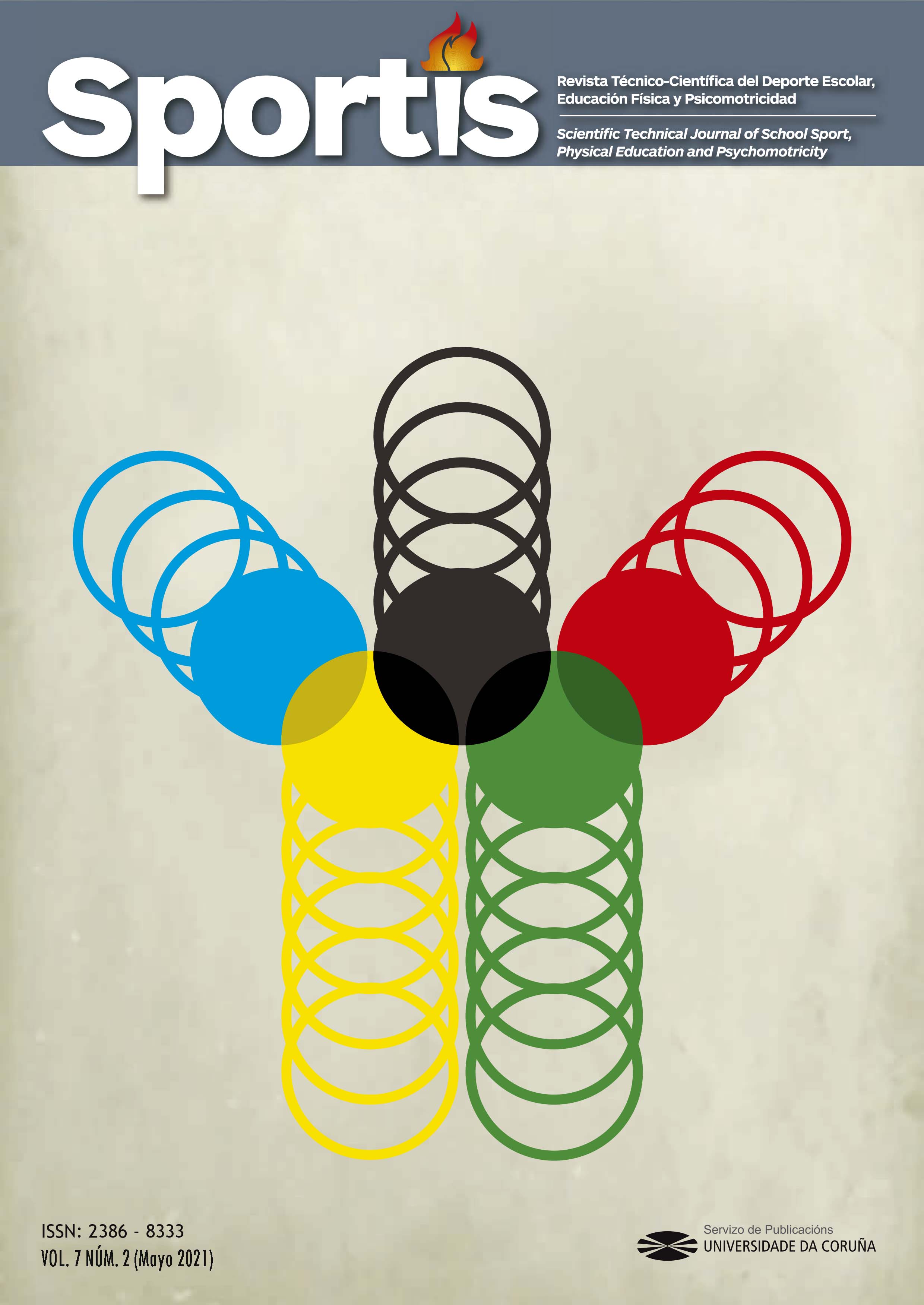Impact of a social network of government dependencies on the dissemination of motor actions during confinement
Main Article Content
Abstract
The new reality in the world, caused by the COVID-19 (SARS-CoV-2) pandemic, has led the daily activities that we knew to a virtual adaptation, physical activity and physical exercise have been mainly one of them throughout the world and in our social contexts. The aim of this study is to carry out an analysis of the virtual strategies that were carried out to carry out exercise, sports, actions, activity and physical education at home, undertaken by some municipalities of Veracruz State, as well as sports institutes of the State of Colima and Nuevo León. The data collected was made through the Facebook® social network, counting the number of actions or strategies undertaken, expressions, shared and reproductions in the case of video graphics material. Among the results found, the main actions include physical exercise with music, as well as guidelines on physical exercise with materials and objects from your home (indoors). The conclusion is clear of the effort of the municipal and state authorities to keep society physically active and impact the health of the body with the benefit of physical activity and sport.
Keywords:
Downloads
Article Details
References
Aquino, y Cols. (2020). COVID-19 y su relación con poblaciones vulnerables. Revista Habanera de Ciencias Médicas, 19.
Blocken, y Cols. (2020). Towards aerodynamically equivalent COVID19 1.5 m social distancing for walking and running. Questions and Answers. Website Bert Blocken, Eindhoven University of Technology (The Netherlands) and KU Leuven (Belgium). Disponibile su: http://www.urbanphysics.net/COVID19.html (ultimo accesso 21 aprile 2020).
Bravo, y Cols. (2020). La actividad física en el contexto de aislamiento social por COVID-19. GICOS: Revista del Grupo de Investigaciones en Comunidad y Salud, 5(2), 6-22.
Camacho, A., y Cols. (2020). Influencia de la actividad física realizada durante el confinamiento en la pandemia del covid-19 sobre el estado psicológico de adultos: un protocolo de estudio. Revista Española de Salud Pública. 2020; Vol. 94: 12 de junio e1-9.
Comisión Municipal del deporte, Alvarado, Veracruz. (2020). Recupero de: https://www.facebook.com/AytoAlvarado/
Comisión Municipal del deporte, Boca del Río, Veracruz. (2020). Recuperado de: https://www.facebook.com/BocaCiudadDeTodos/
Comisión Municipal del deporte, Veracruz, Veracruz. (2020). Recuperado de: https://www.facebook.com/Ayuntamiento.Ver/
Corsini, y Cols., (2020). Football cannot restart soon during the COVID-19 emergency! A critical perspective from the Italian experience and a call for action. British Journal of Sports Medicine, 0(0), 1-2. https://doi.org/10.1136/bjsports-2020-102306
Cortis, y Cols., (2020). Home is the new gym: exergame as a potential tool to maintain adequate fitness levels also during quarantine. Human Movement, 21(4), 1-9. https://doi.org/10.5114/hm.2020.94826
Diario Oficial de la Federación. (2020). Acuerdo por el que se establecen acciones extraordinarias para atender la emergencia sanitaria generada por el virus SARS-CoV2. Disponible en: https://www.dof.gob.mx/nota_detalle.php?codigo=5590914&fecha=31/03/2020&print=tru
Dixit S. (2020). Can moderate intensity aerobic exercise be an effective and valuable therapy in preventing and controlling the pandemic of COVID-19?. Medical Hypotheses, 143, 109854. https://doi.org/10.1016/j.mehy.2020.109854
Gallego, y Cols. (2020). The COVID-19 outbreak and implications for the Tokyo 2020 Summer Olympic Games. Travel medicine and infectious disease, 34, 101604. https://doi.org/10.1016/j.tmaid.2020.101604
Gambau, V., (2020). COVID-19: La crisis ha afectado a todos. Revista española de educación física y deportes -REEFD. ISSN: 1133-6366 y ISSNe: 2387-161X. Número 429, año LXXII, 2º trimestre.
Hammami, y cols. (2020). Physical activity and coronavirus disease 2019 (COVID19): specific recommendations for home-based physical training. Managing Sport and Leisure, 4, 1-6. https://doi.org/10.1080/23750472.2020.1757494
Instituto Colimense del Deporte. (2020). Recuperado de: https://www.facebook.com/Instituto-Colimense-del-Deporte-320237571656209/
Instituto de Estatal de Cultura Física y Deporte. (2020). Recuperado de: https://www.facebook.com/nlindeoficial/?epa=SEARCH_BOX
Instituto Nacional de Estadística y Geografía. (2010). Alvarado, Veracruz, disponible en: https://www.inegi.org.mx/app/areasgeograficas/?ag=06
Instituto Nacional de Estadística y Geografía. (2010). Boca del Río, Veracruz, disponible en: https://www.inegi.org.mx/app/areasgeograficas/?ag=06
Instituto Nacional de Estadística y Geografía. (2010). Estado de Colima, disponible en: https://www.inegi.org.mx/app/areasgeograficas/?ag=06
Instituto Nacional de Estadística y Geografía. (2010). Estado de Nuevo León, disponible en: https://www.inegi.org.mx/app/areasgeograficas/?ag=06
Instituto Nacional de Estadística y Geografía. (2010). Veracruz, Veracruz, disponible en: https://www.inegi.org.mx/app/areasgeograficas/?ag=06
Leng, H. K., & Phua, Y. X. (2020) Athletes as role models during the COVID-19 pandemic. Managing Sport and Leisure, 25(4), 1-5. https://doi.org/10.1080/23750472.2020.1762330
Lista-Paz, A., González Doniz, L., & Souto-Camba, S. (2020). ¿Qué papel desempeña la Fisioterapia en la pandemia mundial por COVID-19?. Fisioterapia. https://doi.org/10.1016/j.ft.2020.04.002
Márquez, J., (2020). Inactividad física, ejercicio y pandemia COVID-19. Revista de Educación Física. Instituto Universitario de Educación Física y Deporte. ISSN 2322-9411. Abril-Junio 2020, Volumen 9 Número 2
Mc Anally, y Cols. (2007). La educación en línea y la capacidad de innovación y cambio de las instituciones de educación. Revista Digital Apertura, Universidad de Guadalajara, México. Vol. 7(7), 82-94, 1665-6180. https://www.redalyc.org/pdf/688/68800707.pdf
Mera, A., y Cols. (2020). Recomendaciones prácticas para evitar el desacondicionamiento físico durante el confinamiento por pandemia asociada a COVID-19. Revista Universidad y Salud. https://doi.org/10.22267/rus.202202.188
Meza, E. I. A., & López, J. A. H. Physical activity in university student athletes, prior and in confinement due to pandemic associated with COVID-19. Retos: nuevas tendencias en educación física, deporte y recreación, (39), 112.
Organización Mundial de la salud. (2020). Comunicación de riesgos y participación comunitaria (RCCE) en la preparación y respuesta frente al nuevo coronavirus de 2019 (2019-nCoV), disponible en: https://apps.who.int/iris/bitstream/handle/10665/330860/9789240001039-spa.pdf
Rodríguez M., Crespo, I., y Olmedillas, H. (2020). Ejercitarse en tiempos de la COVID-19: ¿qué recomiendan hacer los expertos entre cuatro paredes? 0300-8932/C2020 Sociedad Española de Cardiología. https://doi.org/10.1016/j.recesp.2020.04.002







